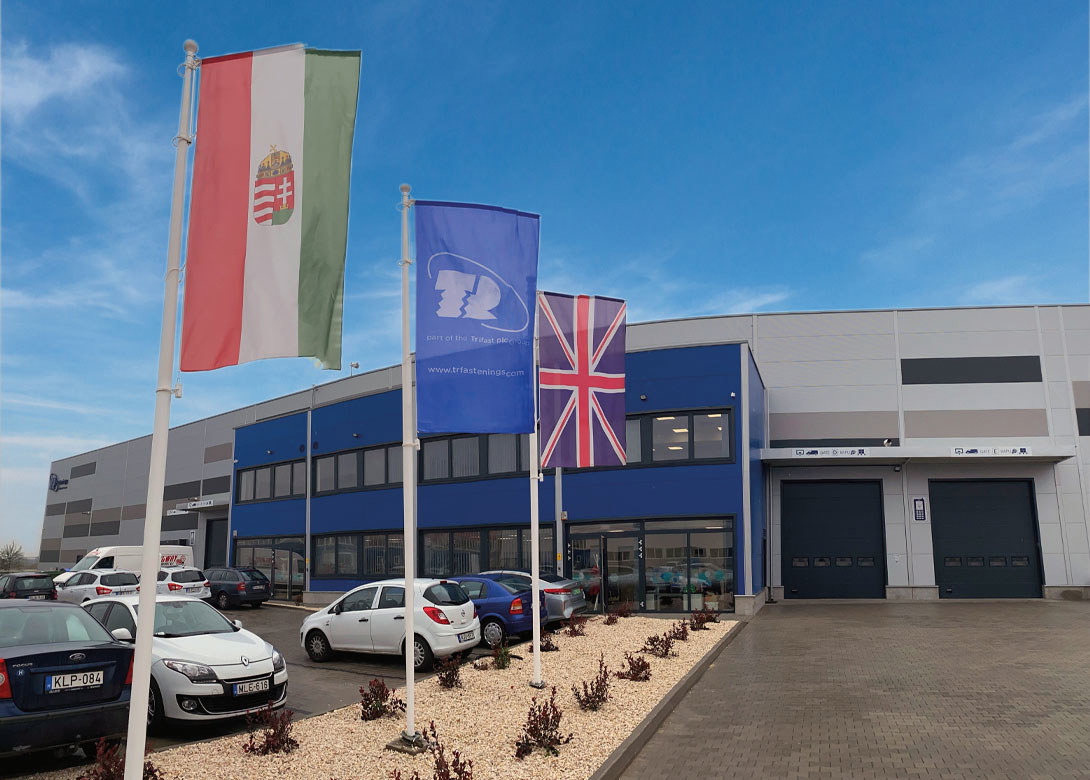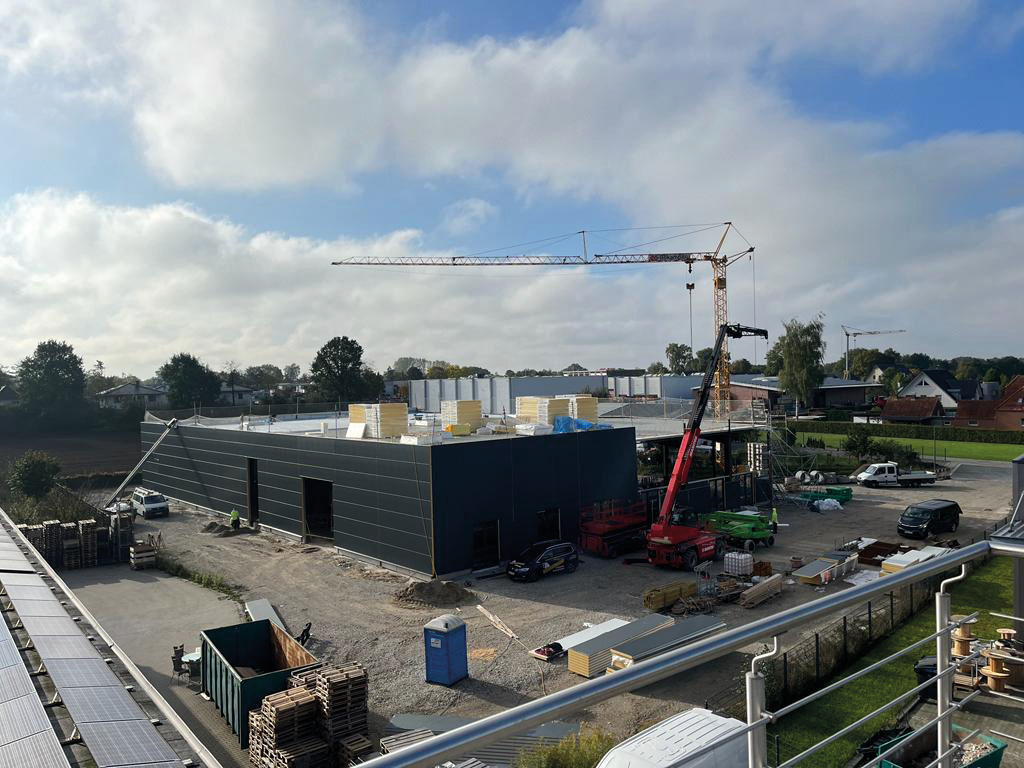
This year TR Fastenings celebrates 50 years within the fastener industry – having seen a dramatic change in the logistics and services required by customers over this period. Here Glenda Roberts, global projects and marketing director at TR Fastenings, charts the key moments in the company’s history and how it met the challenges and opportunities that came its way.
TR Fastenings was founded by Mike Timms and Mike Roberts, whom the company is named after, in Uckfield, East Sussex – an area that was hardly the centre of the fastener world at that time, as the major UK fastener manufacturers and suppliers were in the Midlands and reigned supreme. Both Mikes came from a background in fasteners having worked for a large turned parts company. They had ambitions to start a different kind of distributor business in the south, as they realised there was a different way of servicing large manufacturers.
Typically, in that era the large fastener producers supplied against a purchase order based on manufacturing batch quantities. They made it in bulk and shipped in bulk. Most customers’ manufacturing facilities had large warehouses to enable them to hold many months of inventory and they had little option but to take that batch quantity and the rule was it was plus or minus 10%. If it was 10% short of what was required, then they had to purchase a new batch quantity.
The Mikes convinced enough large companies in the south that they could deliver on a weekly or monthly basis their exact requirements, reducing stocks and cost, etc. This necessitated working with the manufacturers in the Midlands and they brokered agreements to have scheduled deliveries of fasteners held against a blanket order. This may not sound groundbreaking in today’s world, but it was a revolution at that time. As their team expanded and the business grew, they added more product to the portfolio. Over time the phrase ‘Just In Time’ became common parley in our industry, but TR were one of the first companies to introduce this into supply chains. To this day, TR Fastenings still uses the number plate JIT TR on one of its vehicles. The 1980s saw manufacturing growth and TR expanded its locations including setting up screw manufacturing in Telford.
When I joined 34 years ago, we had five locations in the UK and Ireland and today we employ approximately 1,400 people and have locations in 18 countries, including seven manufacturing facilities, which underlines how far we have come.
Leaning the supply chain
In the 1990s change came in the form of the DTI, the Department of Trade and Industry, who asked us to participate in a ‘Managing in the 90s’ programme. There was a wind of change happening where suddenly cheaper household products, such as small domestic appliances, were being imported from Asia. The DTI anticipated this escalating and started to look for partner companies such as TR to help manufacturing companies become lean. This was a new concept for many and Malcolm Diamond, our UK MD at the time, and I hosted visits to our HQ or visited companies, with the DTI, where other speakers talked about how we could all assist in leaning their supply chain.
We further developed our logistic systems including feeding straight to the production line – eliminating waste, time and improving overall efficiencies. At that time, it took some selling to convince people this was the way to progress, as naturally everyone was sceptical that we would deliver one less washer in the bag to the bin. One customer commented at the time ‘People have had their eyes opened, and TR can help us to initiate change. The fact that they are managing our fasteners is almost secondary to some of the other initiatives that have taken place because of it’.
Today, many global companies building a new facility often do not include a warehouse as they expect the product to arrive ‘On Time In Full’ (OTIF) with order fulfilment and demand planning via EDI.
Working with Asia
We imported our first fastener parts from Taiwan 35 years ago and this was a huge learning curve – having never had to manage freight and customs before. Without the internet and mobile phones, etc, there was a reliance on telex and fax machines and personal visits. I sometimes wonder how we ever did business then, as today everything is so immediate and information is at our fingertips. Many of our early relationships forged in those days are still in place today. 
Our supply chain expanded in Asia as suddenly manufacturers were driving us towards ‘low cost countries’ as they strained to get their costs down. We opened our manufacturing locations initially in Singapore and Taiwan and grew our suppliers – adding increased product ranges. Suddenly we were shipping containers of products and managing our logistic operations became a key focus, as it was such an important step in our development. Managing production lines based on longer lead times from Asia was a logistics challenge and our IT team developed systems to give us greater visibility. Today, our freight forwarders provide us portal access to enable us to see end-to-end where goods are in transit. Additional critical data on carbon emissions is provided, and the all-important customs support and advice.
Meeting challenges
In 1999 we, like many companies, prepared for the ‘Millennium Bug’ and concerns about what this could do to interrupt supply chains. Contingency plans were put in place to ensure that we had enough stock in the right place, so we were not the ones that stopped a production line. Manual backups in case our computer systems would switch off at midnight were put in place, and of course this never happened. However, at the time it could have been disastrous on many fronts.
We continued to develop Direct Line Feed systems globally, mainly working with UK and European companies who had transitioned to lower cost countries such as China, India and laterally Mexico – who knew the service we could provide. Coaching personnel in TR sites to manage DLF systems was key and on a number of occasions we also helped these companies teach other component suppliers how to provide lean logistics. One such event sticks in my mind when I was asked to speak at NCR’s (an ATM manufacturer that we supply globally) conference in India – to talk to their suppliers about lean build and the benefits as we had previously done in China. I had not realised that there were over 300 suppliers attending and from that event we generated business with some of these companies.
On 11th September 2001 we all saw the horror that was 9/11. As we mourned that disaster and in a state of shock, we had to turn our attention to the fact that all flights had been cancelled to and from North America. Weekly we received two air freight containers from North America to support several computer manufacturers in Scotland during the Scottish Silicon Glen boom period. Fortunately, everyone in their supply base pulled together to maintain supply until flights resumed.
Preparing for BREXIT consumed our time for several years – assessing risks and trying to plan for every eventuality. The logistical challenges, customs documentation and transport issues the vote to leave the European Union caused were immeasurable. From the UK we supplied 33 Master Distributors across Europe – who market our proprietary ranges, such as self-clinch products and fasteners for plastic. We took the decision after some months of logistical challenges to move the stock and the management of these important customers to our company TR Kuhlmann in Verl, Germany. An extension to its building was needed to house a further 500 pallets. Its business has continued to grow organically and this has necessitated the building of a new warehouse alongside our existing site to manage the future growth (pictured above). This is close to completion and will house an additional 1,200 pallets.
TR Hungary also moved to a new purpose built site to manage its growth and supply to customers in the seven countries on its border. It continues to develop its DLF logistics to customers in that region1. 
Planning for the future
This year in the UK the decision was taken to change our business model and create a modern warehouse, an engineering centre and centralising other key functions. This is designed to improve our customer service and create a more efficient and cost-effective National Distribution Centre, NDC in the West Midlands. This is a significant investment in a 75,000 square foot purpose built warehouse positioned off junction 10 on the M6. This gives better access to motorway routes and our other locations remain as customer service centres. It is no longer economic to house stock in multiple locations and although this is a challenging task, we know that this will future proof our business for years to come.
There are always new challenges, and we are in the midst of managing the Russian Sanctions Directive, which is time-consuming, and we have the delights of CBAM to think about next, but at TR Fastenings we always look to meet global challenges head on and see how we can turn them into opportunities for us as business.
1 https://www.trfastenings.com/company/newsroom-and-media/press-releases/new-facility-in-hungary

Will joined Fastener + Fixing Magazine in 2007 and over the last 15 years has experienced every facet of the fastener sector - interviewing key figures within the industry and visiting leading companies and exhibitions around the globe.
Will manages the content strategy across all platforms and is the guardian for the high editorial standards that the Magazine is renowned.
Don't have an account? Sign Up
Signing up to Fastener + Fixing Magazine enables you to manage your account details.